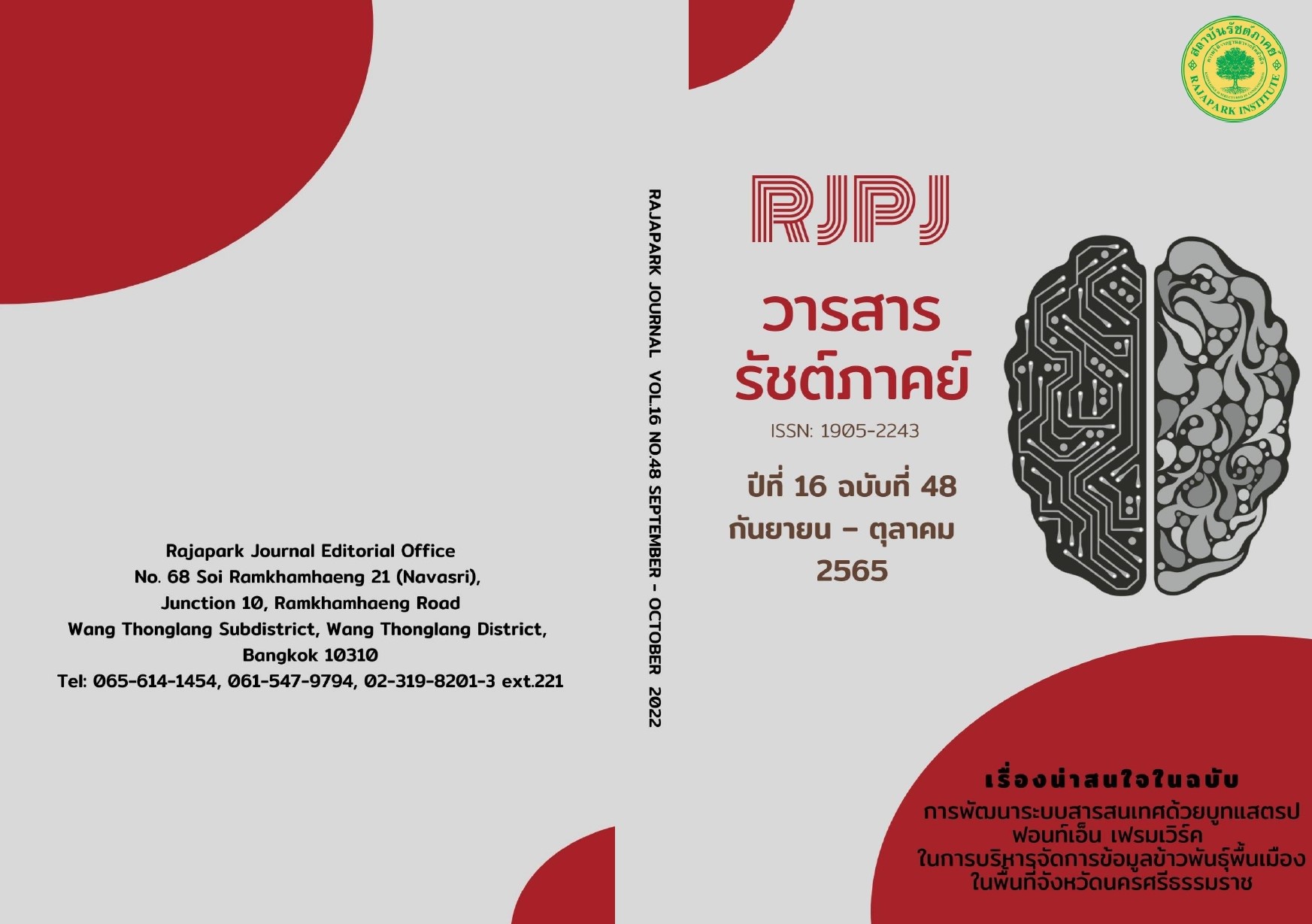Determinant Factors of Hedonic Benefits Pending Supermarket Sales Promotions Display to Consumers in Bangkok Metropolitan Region
Main Article Content
Abstract
The purpose of this research has studied and analyzed for determinant factors which generates hedonic benefits pending supermarket sales promotions display to consumers in Bangkok Metropolitan Region with stratified random sampling technique was applied to select 412 consumers to answer self-reported questionnaires. Data were analyzed by Structure Equations Model (SEM) with 95% reliability of online questionnaire. Research finding show that an appearance structure has harmoniously with empirical data which is divided by characteristic into four types of sales promotions.Price Cut has had (chi-square) 384.1, (RMSEA) 0.077, (SRMR) 0.043, (CFI) 0.947, (TLI) 0.936 and (CD) 0.954, Free Products has had (chi-square) 328.2, (RMSEA) 0.076, (SRMR) 0.040, (CFI) 0.961, (TLI) 0.953 and (CD) 0.974, Free Gifts has had (chi-square) 515.3, (RMSEA) 0.094, (SRMR) 0.043, (CFI) 0.949, (TLI) 0.938 and (CD) 0.991 and Sweepstakes has had (chi-square) 648.4, (RMSEA) 0.112, (SRMR) 0.051, (CFI) 0.937, (TLI) 0.924 and (CD) 0.999. Results indicated that Free Products has given the most hedonic benefits to the consumers at .98 then Price Cut at .94, Sweepstakes at .90 and Free Gifts at .89, and besides the utilitarian benefits and the hedonic benefits of the consumers have had relatedness significantly at 0.05.
Article Details

This work is licensed under a Creative Commons Attribution-NonCommercial-NoDerivatives 4.0 International License.
Views and opinions appearing in the Journal it is the responsibility of the author of the article, and does not constitute the view and responsibility of the editorial team.
References
Abbasi, R., Mandani, M., Keshavarz, S., & Marzban, S. (2017). The effect of promotion mix the intention of buying stocks with an emphasis on brand equity (Case Study: Tehran Stock Exchange). In The International Conference on Management and Humanities 4th. Paris: World Academy of Science Engineering and Technology.
Abdelhamied, H. (2013). The effects of sales promotion on post promotion behaviors and brand preferences in fast food restaurants. Tourismos: An International Multidisciplinary Journal of Tourism, 8(1), 93-113.
Aungsuchot, S., Wijitwanna, S. & Pinyopanuwat, R. (2011). Statistics Analysis for Social and Behavioral Research. CDMK Printing.
Batra, R., & Ahtola, O. T. (1991). Measuring the hedonic and utilitarian sources of consumer attitudes. Marketing letters, 2(2), 159-170.
Campbell, L., & Diamond, W. D. (1990). Framing and sales promotions: The characteristics of a “good deal”. Journal of Consumer Marketing. 7(4), 25-31.
Chaharsoughi, S. A., & Hamdard, J. (2011). The Affect of sales promotion on consumer interest to purchase in IKCO automotive company. Journal of knowledge management, economics and information technology, 4(1), 1-17.
Chandon, P., Wansink, B., & Laurent, G. (2000). A benefit congruency framework of sales promotion effectiveness. Journal of marketing, 64(4), 65-81.
Cochran, W. G. (1977). Sampling techniques (3rd ed.). John Wilay & Sons.
Dotson, M.J. (2001). Sales Promotion Preferences: A Demographic Analysis. Appalachian State University.
Fam, K. S., Brito, P. Q., Gadekar, M., Richard, J. E., Jargal, U., & Liu, W. (2019). Consumer attitude towards sales promotion techniques: a multi-country study. Asia Pacific Journal of Marketing and Logistics, 31(4), 121-148.
Gedenk, K., Neslin, S.A., & Ailawadi, K.L. (2010). Springer.
Jallow, H., & Dastane, O. (2016). Effect of sales promotion schemes on purchase quantity: A study of Malaysian consumers. Management & Marketing, 14(2), 299-320.
Jaroonsawat, C. (2020). Statistics for Data Analysis. Kisuka.
Khan, M. A., Tanveer, A., & Zubair, S. S. (2021). Impact of sales promotion on consumer buying behavior: a case of modern trade,
Pakistan. Governance and Management Review, 4(1), 38-53.
Kotler, P., & Armstrong, G. (2015). Principles of marketing (15th ed.). Pearson Prentice-Hall.
Liao, S. L., Shen, Y. C., & Chu, C. H. (2009). The effects of sales promotion strategy, product appeal and consumer traits on reminder impulse buying behaviour. International Journal of Consumer Studies, 33(3), 274-284.
Mittal, M., & Sethi, P. (2011). The effectiveness of sales promotion tools among Indian consumers: An empirical study. Journal of Promotion Management, 17(2), 165-182.
Mishra, M., Das, A., Kulkarni, P., & Sahoo, A. (2012) Dynamic resource management using virtual machine migrations. IEEE Communications Magazine, 50(9), 34-40.
Ofosu-Boateng, I. (2020). Influence of consumer sales promotion on consumers’ purchasing behaviour of the retailing of consumer goods in Tema, Ghana. Journal of Marketing Management, 8(1), 24-36.
Reid, M., Thompson, P., Mavondo, F., & Brunso, K. (2015). Economic and utilitarian benefits of monetary versus non-monetary in-store sales promotions. Journal of Marketing Management, 31(3-4), 247-268.
Shi, Y. Z., Cheung, K. M., & Prendergast, G. (2005). Behavioural response to sales promotion tools: a Hong Kong study. International Journal of Advertising, 24(4), 469-489.
Sinha, S. K., & Verma, P. (2020). Impact of sales Promotion's benefits on perceived value: Does product category moderate the results?. Journal of Retailing and Consumer Services, 52, 1-11.
Soleimani, A., & Sedaghat, S. (2016). Advertising And Sales Promotion Effects on Brand Equity: A Case Study of Iran Insurance Company. Ng-Journal of Social Development, 5(5), 204-217.
Steven Ogden-Barnes & Stella Minahan. (2015). Sales Promotion Decision Making Concepts, Principles, and Practice. Business Expert.
Yang, L., Cheung, W.L., Henry, J., Guthrie, J., & Fam, K.S. (2010). An examination of sales promotion programs in Hong Kong: What the retailers offer and what the consumers prefer. Journal of Promotion Management, 16(4), 467-479.


